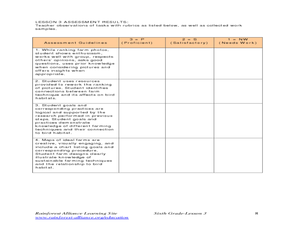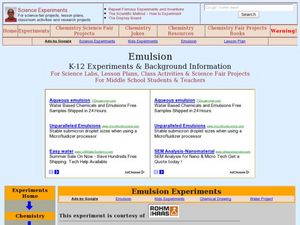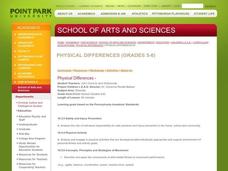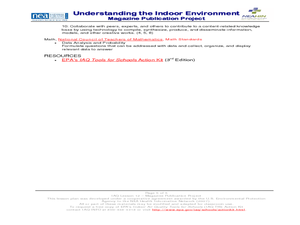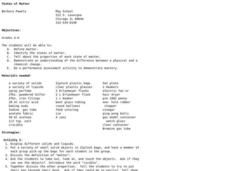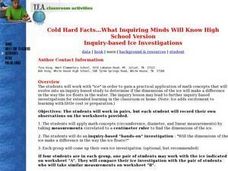Curated OER
Elements 'R' Us
Sixth graders participate in a Web Quest in order to examine the periodic table of elements. After collecting information about an element of their choice, they share with group members what they have learned. Groups create class...
Curated OER
Exercise and Heartrate
Fourth graders experiment to find the effects of exercise on the heart rate. In this exercise and heart rate lesson, 4th graders create questions about exercise and heart rate. Students use the scientific method to test and analyze...
Curated OER
How can my breakfast help the birds?
Sixth graders design farms with a bird's habitat in mind. In this farm lesson plan, 6th graders research how sun grown coffee destroys a bird habitat, and then they make their own farm with a bird's habitat being preserved. They then...
Curated OER
Emulsions
Students identify the characteristics and composition of emulsions. In this chemistry lesson, students classify household products according to emulsion type. They explain how to make the best emulsion.
Curated OER
Something Fishy Going On
Learners create a video animation of how Swimmy gathered his fish friends together to form a great big fish that would frighten the predator tuna away. In art class each child create a small red fish which gets displayed in the ocean...
Curated OER
Designing Machines
Students explore simple and compound machines. In groups of four students, they design a compound machine using K'NEX that has a stated purpose and consists of at least two simple machines.
Curated OER
Investigative Case - Protistan Tales of Atlantic White Cedar Swamps
Students use this WebQuest to explore the vast diversity of microbes, especially those microbes of the Atlantic Cedar Swamps. They tell a story about the protests of the Atlantic Cedar Swamp in the form of anthropomorphism.
Curated OER
Diversity
Students access prior knowledge of the five senses and relate to students with disabilities. In this people with disabilities instructional activity, students research and use a Venn diagram to compare and contrast famous people and...
Curated OER
Microphones
In this microphones worksheet, students answer five questions about different types of microphones such as moving coil, crystal, and carbon microphones.
Curated OER
Using a Compass
Young scholars determine how to shoot a bearing. In this compass and orienteering lesson, students review the parts of a compass, practice how to find a bearing and work in groups to practice finding landmark bearings.
Curated OER
Kalahari Explorations
Students explore world geography by completing graphic organizers and researching the Internet. In this Kalahari desert instructional activity, students identify the geographic location, weather and creation of the Kalahari desert....
Curated OER
Indoor Environment: A Magazine Publication Project
Students demonstrate knowledge of Indoor Air Quality by creating a class magazine. A link to order a free Action Kit from the U.S. Environmental Protection Agency is provided so teachers can build background knowledge. Performance...
Curated OER
Water Wonders
Students explore hydrology concepts. In this environment and biology instructional activity, students identify and describe macroinvertebrates using a variety of pictures and resources. Students observe and write about a classroom...
Curated OER
Cardiac Arrest! Using Forensics to Investigate Cardiovascular Anatomy and Function
Learners identify the different parts and functions of the cardiovascular system. In this forensics lesson, students collect and analyze evidence on a fictional crime. They describe different causes of cardiac arrest.
Curated OER
T-Shirt Chromatography
Students study about chromatography, a process used to separate mixtures. They see that chromatography is used to detect, separate or purify different substances. This nice lesson results in a beautiful t-shirt for each student!
Curated OER
States of Matter
Students examine the properties of solids, liquids, and gasses. In this states of matter lesson plan, the teacher guides students through a series of experiments to illustrate each state of matter and how matter changes from one state...
Curated OER
What is the Attraction?
Second graders investigate the law of polarity. In this magnets instructional activity, 2nd graders discover how magnets are used in everyday life and which objects in our environment are magnetic. Students experiment with bar magnets...
Curated OER
Werner Heisenberg
In this online interactive history quiz learning exercise, learners respond to 50 multiple choice questions about the accomplishments of Werner Heisenberg. Students may submit their answers to be scored.
Curated OER
Max Planck
In this online interactive history quiz worksheet, high schoolers respond to 49 multiple choice questions about the accomplishments of Max Planck. Students may submit their answers to be scored.
Curated OER
Electromagnetism
Young scholars explore the generation of magnetic fields from currents in wires and measure the magnetic field directions. They measure magnetic fields in their own environment. They also examine how moving magnetic fields can create...
Curated OER
What's in a Willow?
Students study of nutritional value of edible native plants. discriminate between foods that have nutritional value and those that do not. They relate how food can affect how they think, feel, and perform.
Curated OER
Cold Hard Facts...What Inquiring Minds Will Know
Students work with "ice" in order to gain a practical application of math concepts that evolve into an inquiry-based study. They determine if the dimensions of the ice make a difference in the way the ice floats in the water.
Curated OER
Stations of Light
Student groups rotate through four stations to examine light energy behavior: refraction, magnification, prisms and polarization. They see how a beam of light is refracted (bent) through various transparent mediums. Students investigate...
Curated OER
Follow Those Tracks
Students observe a picture containing patterns of animal tracks, infer what might have happened based upon the pattern of tracks, and write a story describing what might have happened.




